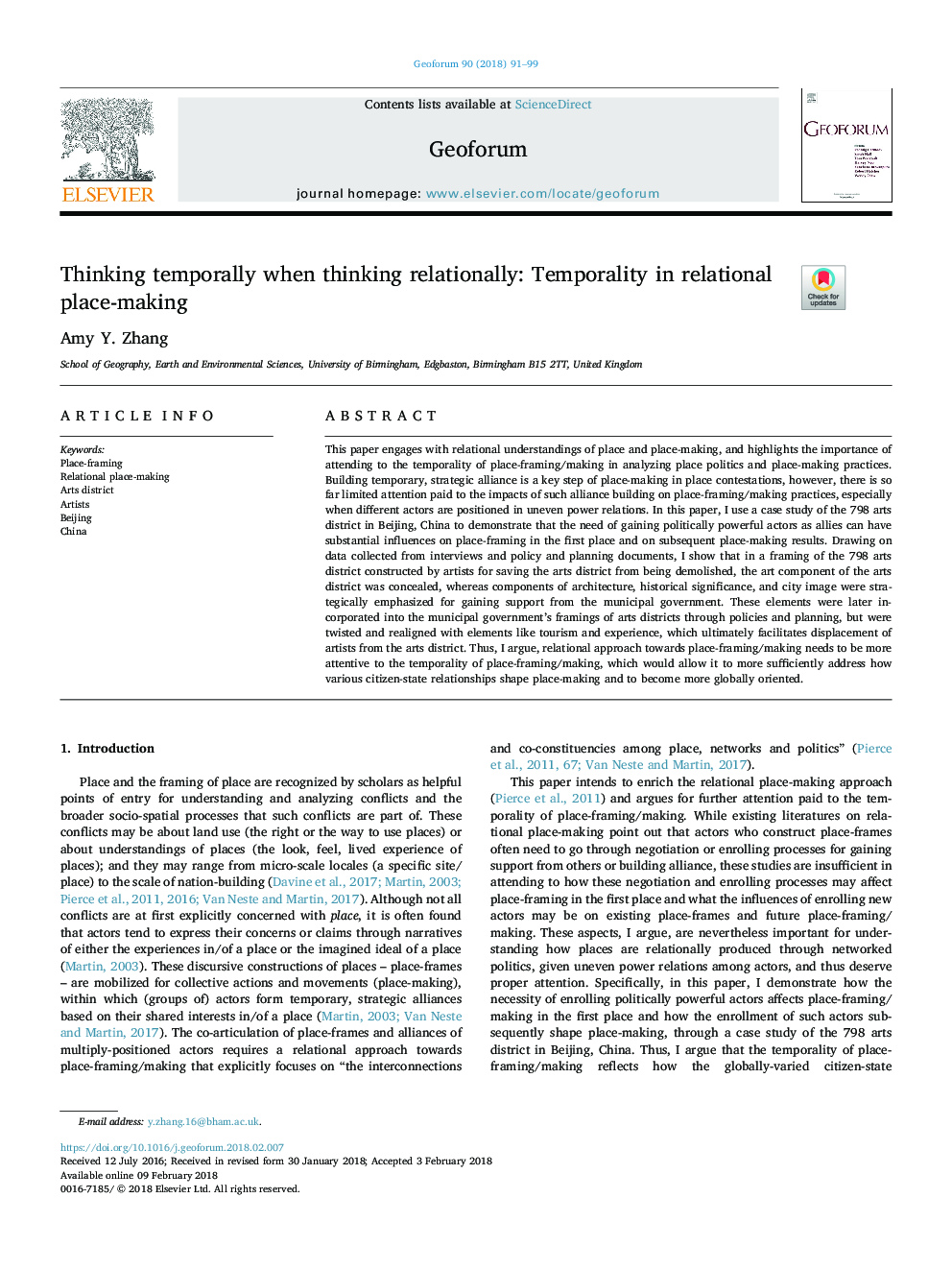| کد مقاله | کد نشریه | سال انتشار | مقاله انگلیسی | نسخه تمام متن |
|---|---|---|---|---|
| 7353742 | 1477099 | 2018 | 9 صفحه PDF | دانلود رایگان |
عنوان انگلیسی مقاله ISI
Thinking temporally when thinking relationally: Temporality in relational place-making
ترجمه فارسی عنوان
فکر زمانبندی زمانی که تفکر ارتباطی دارد: زمانبندی در موقعیت مکانی ارتباطی
دانلود مقاله + سفارش ترجمه
دانلود مقاله ISI انگلیسی
رایگان برای ایرانیان
کلمات کلیدی
فریم محل ایجاد مکان ارتباطی، منطقه هنر، هنرمندان، پکن، چین،
ترجمه چکیده
این مقاله با درک مفاهیم مکان و مکان، و اهمیت مشارکت در زمانبندی مکانیزاسیون / ساختن در تجزیه و تحلیل سیاست های مکان و شیوه های مکان سازی را مورد توجه قرار می دهد. ایجاد اتحاد موقت و استراتژیک، یک گام کلیدی برای ایجاد مشاغل در محل است؛ با این حال، تا کنون توجه محدود به تأثیرات چنین ساختگی در ساخت و ساز بر اساس مکان / ساخت و ساز، به ویژه هنگامی که بازیگران مختلف در قدرت ناهموار قرار می گیرند روابط در این مقاله، من از مطالعه موردی 798 منطقه هنری در پکن، چین استفاده می کنم تا نشان دهد که نیاز به دست آوردن بازیگران قدرتمند سیاسی به عنوان متحدان می تواند تأثیرات قابل توجهی بر جای گذاری در مرحله اول و در نتیجه نتایج مکان های بعدی داشته باشد. بر اساس اطلاعات جمع آوری شده از مصاحبه ها و اسناد سیاستگذاری و برنامه ریزی، نشان می دهم که در بخش 798 منطقه هنری که توسط هنرمندان ساخته شده است برای نجات بخش هنر از تخریب، بخش هنری منطقه هنر پنهان شده است، در حالی که اجزای معماری، اهمیت تاریخی و تصویر شهر به طور استراتژیک برای کسب حمایت از دولت شهرداری تأکید شده است. این عناصر بعدها از طریق سیاست گذاری و برنامه ریزی، به ساختارهای اداری شهرداری های مناطق هنری تبدیل شدند، اما پیچیده شده و با عناصری مانند گردشگری و تجربه، که در نهایت باعث جابجایی هنرمندان از منطقه هنری شد، را تسهیل می کند. بنابراین، من استدلال می کنم، رویکرد رابطه ای به سمت ساختار / ساختن نیاز به توجه بیشتر به زمانبندی فریم / ساختن، که به آن اجازه می دهد تا بیشتر به اندازه کافی در مورد چگونگی روابط مختلف شهروندی دولت شکل می گیرد و تبدیل شدن به بیشتر جهانی گرا
موضوعات مرتبط
علوم انسانی و اجتماعی
اقتصاد، اقتصادسنجی و امور مالی
اقتصاد و اقتصادسنجی
چکیده انگلیسی
This paper engages with relational understandings of place and place-making, and highlights the importance of attending to the temporality of place-framing/making in analyzing place politics and place-making practices. Building temporary, strategic alliance is a key step of place-making in place contestations, however, there is so far limited attention paid to the impacts of such alliance building on place-framing/making practices, especially when different actors are positioned in uneven power relations. In this paper, I use a case study of the 798 arts district in Beijing, China to demonstrate that the need of gaining politically powerful actors as allies can have substantial influences on place-framing in the first place and on subsequent place-making results. Drawing on data collected from interviews and policy and planning documents, I show that in a framing of the 798 arts district constructed by artists for saving the arts district from being demolished, the art component of the arts district was concealed, whereas components of architecture, historical significance, and city image were strategically emphasized for gaining support from the municipal government. These elements were later incorporated into the municipal government's framings of arts districts through policies and planning, but were twisted and realigned with elements like tourism and experience, which ultimately facilitates displacement of artists from the arts district. Thus, I argue, relational approach towards place-framing/making needs to be more attentive to the temporality of place-framing/making, which would allow it to more sufficiently address how various citizen-state relationships shape place-making and to become more globally oriented.
ناشر
Database: Elsevier - ScienceDirect (ساینس دایرکت)
Journal: Geoforum - Volume 90, March 2018, Pages 91-99
Journal: Geoforum - Volume 90, March 2018, Pages 91-99
نویسندگان
Amy Y. Zhang,
